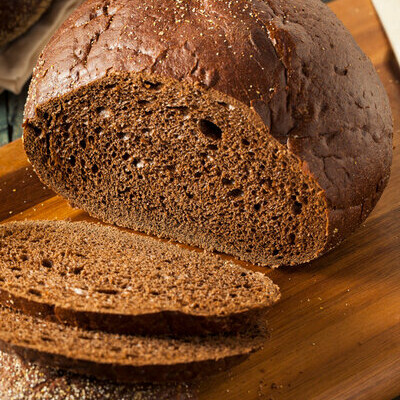
Pumpernickel Bread
Also known as dark rye bread
What is Pumpernickel Bread?
Pumpernickel bread is one type of rye bread which is prepared with little or no wheat flour addition. Its name comes from the word “pumpernickel flour” which is a coarsely ground whole rye meal with a dark color.
Pumpernickel bread generally makes use of a “sour” or sourdough for CO2 production and dough leavening. The resultant bread has a:
- Unique flavor profile
- Dark, dense and moist crumb
- Lack of the typical resilience and springiness of wheat-based breads
Origin
Pumpernickel and other rye breads have been consumed in European countries for centuries. American pumpernickel breads are quite different from the original German and Eastern Europe pumpernickel bread which only uses rye as cereal flour in the recipe. The American version uses low or high amounts of wheat flour, plus some caramel color, to make higher volume and more tender breads.
How is pumpernickel bread made?
Rye breads have a very distinctive rye-like flavor and, depending on the formulation, may exhibit very strong acidic taste profiles. These breads are often spiced with caraway seed or other spices.
Typical formulation of a pumpernickel bread with wheat flour addition
| Ingredient |
Baker’s % (based on flour weight) |
|---|---|
| Rye starter or fully mature sourdough | Rye starter or fully mature sourdough |
| Rye flour | 20.0 |
| Water | 20.0 |
| Instant dry yeast (for rye starter only) | 0.5 |
| Dough | Dough |
| Whole rye meal (pumpernickel) | 70.0 |
| Clear flour (wheat) | 30.0 |
| Rye starter or mature sourdough | 40.5 |
| Water | 55.0 |
| Instant dry yeast (IDY) | 1.0 |
| Salt | 2.0 |
| Honey (or molasses) | 3.0 |
| Caramel color | 0.2 |
| Ground Caraway seeds | 0.5 |
| Total | 201.45 |
Processing
Rye bread production has essentially the same processing steps as the production of whole or multigrain bread. Because of the characteristics of the rye flour, processing must be modified to varying degrees, depending on the amount of wheat flour that is added to compensate for the lack of unique glutenins found in wheat.
- Rye starter preparation
- Mix together all ingredients.
- Cover and let the yeast-based rye starter ferment at room temperature for about 15 hours
- In case of using a sourdough process, bear in mind that it should be fully mature and bubbly before use at dough level
- Dough mixing: incorporate dry and liquid dough ingredients at low speed for 3 min. Switch to high speed and continue mixing to full gluten development on the wheat flour side. Mixing at high-speed usually takes about 8 to 12 minutes at a final dough temperature of 26°C (79°F). Mixing time and/or hydration for proper rheology increase as wheat flour amount increases.
- Bulk fermentation: cover bowl with plastic wrap and let sit for 30–60 minutes at room temperature.
- Makeup and panning
- Dividing: Scaling weight of dough piece 1.5 pound (700 g)
- Pan dimensions: 4 1/4 width x 8 7/8 length x 4 5/64 depth for total 153 cu in volume (2,500 cc)
- Dough-to-pan ratio: 600 / 2500 = 0.28 g / cc (heavy weight)
- Rounding, sheeting and moulding for proper dough forming according to pan dimensions
- Final proofing
- Allow dough piece to rise at 95°F (35°C) and at a RH of 80% for about 40 minutes
- Rye doughs have much less tolerance to over-fermentation than whole wheat doughs so care must be taken to prevent collapse prior to transfer to the oven
- Rye doughs are not required to expand several times their initial volume as wheat-based doughs.
- Baking: bread quality and product flavor are influenced by the baking process. Optimum baking temperature and time depend on the weight and the shape of the loaf. Rye bread requires a stable, solid heat within a temperature range of 450°F (230°C) for 30 to 40 minutes
- Cooling: remove product from sheet and allow it to cool at room conditions to an internal temperature of 32°C (90°F). Cooling usually takes 60 to 90 minutes to reach the final temperature.
- Packaging or serving
Application
The major difference between wheat flour and rye flour is that wheat contains gluten-forming proteins, both glutenins and gliadins, whereas rye flour proteins are incapable of producing the polymeric gluten network that is necessary for bread structure. The absence of gluten-forming proteins of rye flour accounts for the limited amount of rye flour that can be incorporated into the dough without causing loss in bread volume, i.e., gas retention by the colloidal system during proofing and baking. It is impossible to produce a large, light and high volume loaf of bread entirely from rye flour.1
References
- Verwimp, T., Courtin, C.M., and Delcour, J.A. “Rye Constituents and Their Impact on Rye Processing.” Food Biochemistry and Food Processing, 2nd Edition, John Wiley & Sons Ltd, 2012, pp. 654–671.

